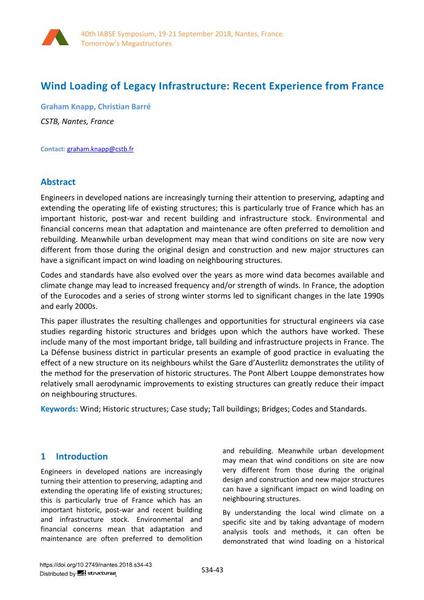Wind Loading of Legacy Infrastructure: Recent Experience from France

|
|
|||||||||||
Détails bibliographiques
| Auteur(s): |
Graham Knapp
(CSTB, Nantes, France)
Christian Barré (CSTB, Nantes, France) |
||||
|---|---|---|---|---|---|
| Médium: | papier de conférence | ||||
| Langue(s): | anglais | ||||
| Conférence: | IABSE Symposium: Tomorrow’s Megastructures, Nantes, France, 19-21 September 2018 | ||||
| Publié dans: | IABSE Symposium Nantes 2018 | ||||
|
|||||
| Page(s): | S34-43 | ||||
| Nombre total de pages (du PDF): | 7 | ||||
| DOI: | 10.2749/nantes.2018.s34-43 | ||||
| Abstrait: |
Engineers in developed nations are increasingly turning their attention to preserving, adapting and extending the operating life of existing structures; this is particularly true of France which has an important historic, post-war and recent building and infrastructure stock. Environmental and financial concerns mean that adaptation and maintenance are often preferred to demolition and rebuilding. Meanwhile urban development may mean that wind conditions on site are now very different from those during the original design and construction and new major structures can have a significant impact on wind loading on neighbouring structures. Codes and standards have also evolved over the years as more wind data becomes available and climate change may lead to increased frequency and/or strength of winds. In France, the adoption of the Eurocodes and a series of strong winter storms led to significant changes in the late 1990s and early 2000s. This paper illustrates the resulting challenges and opportunities for structural engineers via case studies regarding historic structures and bridges upon which the authors have worked. These include many of the most important bridge, tall building and infrastructure projects in France. The La Défense business district in particular presents an example of good practice in evaluating the effect of a new structure on its neighbours whilst the Gare d’Austerlitz demonstrates the utility of the method for the preservation of historic structures. The Pont Albert Louppe demonstrates how relatively small aerodynamic improvements to existing structures can greatly reduce their impact on neighbouring structures. |
||||
| Mots-clé: |
vent ponts
|
||||
